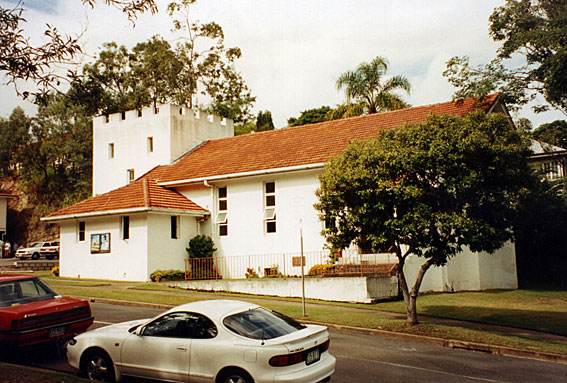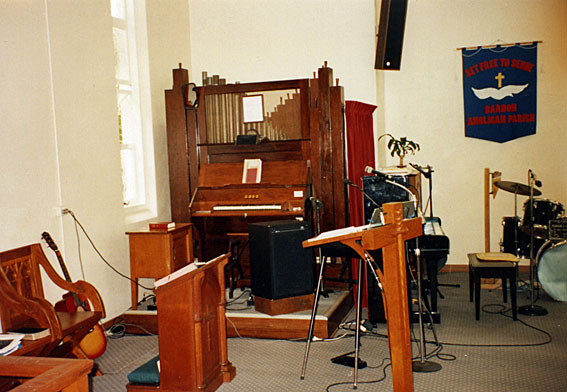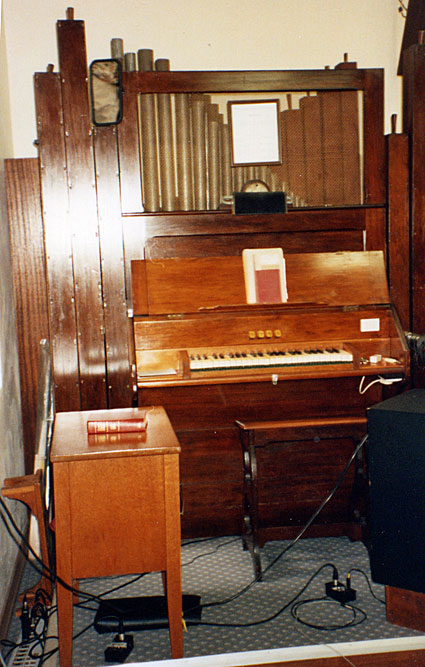
St Mary's Anglican Church, Bardon
[Photograph by Howard Baker (early 1990s)]

St Mary's Anglican Church, Bardon
[Photograph by Howard Baker (early 1990s)]
Historical and Technical Documentation by Geoffrey Cox
© OHTA 2012, 2013 (last updated May 2013)
The organ that existed in this church between 1977 and c.1995 was built by B.B. Whitehouse & Co. for St Mark's Anglican Church, Albion (Clayfield).1 It was dedicated at Albion on Sunday 6 July 1919 as a memorial to the fallen in the First World War,2 and was moved to the new brick church at Albion, which was opened in May 1964.3
This was one of two identical instruments built by the firm around the same time, the other being for St Augustine's Church, Hamilton (1918), but no longer extant. These two were followed later by another two of similar design, but of different compass from the earlier two: for St John's Anglican Church, Cairns (1927, no longer extant) and Zion Lutheran Church, Minden (1931).


The 1919 B.B. Whitehouse & Co. organ
at St Mary's Anglican Church, Bardon
[Photographs by Howard Baker (early 1990s)]
Within the context of the Whitehouse output, these four were distinctive in having only one manual, no pedals, completely unenclosed pipework, and employing a 'melodic bass' stop at 16ft pitch. Such melodic stops had already existed in Queensland on two organs built by the Positive Organ Co. of London, located originally at the Catholic Apostolic Church, South Brisbane (date not recorded), and Holy Trinity Anglican Church, Mackay (1890s). These imported instruments may have served as the model for the use of melodic stops by the Whitehouse firm.
The Albion organ was moved to St Mary's Anglican Church, Bardon, in 1977 by Whitehouse Bros.4 It was offered for sale at Bardon in 1994-95,5 and eventually sold Mr Colin Middleton of Middleton's Printers, Caboolture. Upon retirement to Bundaberg around 2000, Mr Middleton sold the instrument to a person from Eumundi (near Noosa) who reportedly owned an Arts & Crafts business there, including beer brewing, and who already had a 2-manual reed organ.6 The current location of the organ has not been identified, despite enquiries to the Eumundi Heritage & Visitors Centre.7
The specification is as follows:
| MANUAL Bourdon Salicional Open Diapason COUPLER Octave Coupler |
16 8 8 |
(Melodic Bass) 20 notes (FF to middle C) (3 octaves)* (3 octaves)* |
Tubular-pneumatic action
Compass: F-F (4 octaves)
Totally unenclosed
No pedals.8
* the lowest octave of these two stops are Bourdon pipes, eight of which were derived from the Bourdon 16ft.
________________________________________________________________
1 Whitehouse Bros List.
2 The Brisbane Courier (5 July 1919), p. 12; The date is given as 1920 in the Whitehouse Bros List, but as July 1919 in Alex P.Kidd, St Mark's on Maida Hill: A History of the First Parish Church of St Mark the Evangelist, Clayfield (Albion), Brisbane, 1888-1964 (Brisbane, 2001); Reference to the organ is also made in: Minutes of Meeting of Parishioners of the Lutwyche Parish held in St Mark's Hall on the 4th December 1918 for the purpose of deciding upon what steps should be taken to purchase a Pipe Organ as a memorial on the termination of the War, for St Mark's Church (cited in records of St Andrew's Lutwyche, at Anglican Diocese of Brisbane, Records and Archive Centre).
3 Dedication of War Memorial Church of St Mark the Evangelist, May 1964 (Anglican Diocese of Brisbane, Records and Archive Centre, CLAMS039, Box 7).
4 Personal communication to G. Cox from Frank Hall (organist, St Mary's Bardon), c.1996.
5 Organ Society of Queensland Newsletter, vol. 1, no. 3 (May 1994), p. 4.
6 Personal communication to G. Cox from Colin Middleton, undated.
7 Personal communications between G. Cox and Wendy Birrell, Manager of the Eumundi Heritage & Visitors Centre, since November 2011.
8 Specification noted by G. Cox at St Mark's, Albion, 1973.